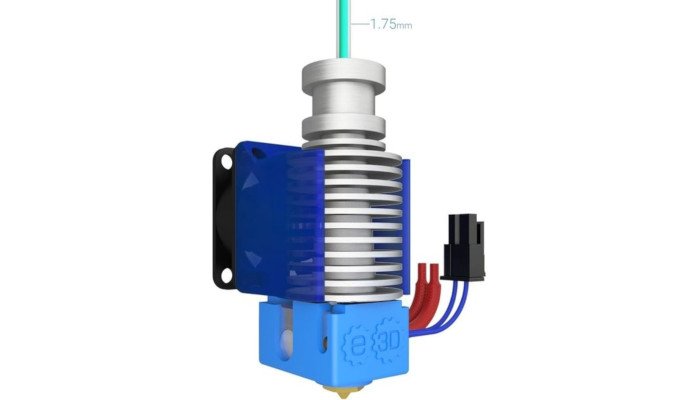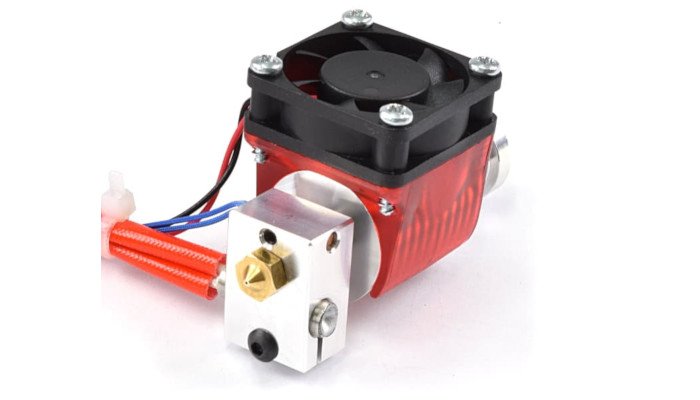A 3D printer hot end makes up part of the extruder, probably the single most important part of an FDM 3D printer. The hot end melts plastic filaments that are then deposited on the print bed to create your 3D model.
So, we’ve rounded up the best 3D printer hot ends to help you make the best decision for your specific needs. Here’s our top pick:
Investing in a good quality hot end is one of the best investments you can make in 3D printing, as they are so integral to print quality and efficiency. A sign of a good hot end is that there are many copies or clones – though we strongly recommend spending the extra $20 and picking up the real deal, ensuring a great 3D printing experience.
- We also have a guide to all the parts of a 3D printer.
Quick Overview
| Name | Best place to buy: | Other purchase option: |
|---|---|---|
| E3D V6 | Amazon here | Matterhackers here |
| E3D Lite6 | Amazon here | Matterhackers here |
| Micro Swiss MK10 All Metal Hot End | Amazon here | |
| Diabase Flexion Single Extruder | Amazon here | |
| Diabase Flexion Dual Extruder | Amazon here | |
| E3D Titan Aero | Amazon here |
Best 3D Printer Hot Ends
1. E3D V6 — Best Hot End Overall

Pros
Works great with tough filaments.
Versatile and compatible with most FDM 3D printers.
Customizable.
Cons
Some feel it hasn’t aged well since it came out.
Considered the best hot end around by makers and 3D printer companies alike, the E3D V6 is a customizable all-metal hot end that works great even with tougher filaments like Nylon. As with all E3D hot ends, parts can easily be replaced and switched out.
It comes as a DIY kit that you will need to assemble yourself, unless you’d prefer to pay more to have it ship assembled. Building it yourself gives you the flexibility you need, as you may want to turn it into a direct or Bowden extruder, or change it to take either 1.75mm or 3mm filaments.
E3D hot ends are extremely versatile, and compatible with almost any FDM 3D printer you can think of. It’s built to be lightweight and precise, meaning you can print with no overshooting at good speeds. Overall, we highly recommend the E3D V6 as one of the best 3D printer hot ends.
2. E3D Lite6 – best 3D printer hot end for beginners

Pros
Good for beginners.
Easy to assemble and mount.
Cons
Limited to standard filaments such as ABS and PLA.
The E3D V6’s baby brother, the Lite6 is one of the best hot ends for beginners to 3D printing. It’s only compatible with 1.75mm filament, so for the minority of makers who prefer 3mm this won’t work for you.
For the lower price, you lose some of the benefits of the E3D V6. Instead of being fully metal, a small number of parts are PTFE-lined, so the Lite6 can’t take on the same high temperatures as the E3D V6. For that reason, it is mostly limited to standard filaments such as ABS and PLA.
Being less customizable than the V6 shouldn’t be a problem for beginners, and it is easier to assemble and mount than its bigger brother. Overall, we recommend it for newer makers and those who want to save time, prefer a less complex hot end, and want to save some money.
3. Micro Swiss MK10 All-Metal Hot End
- Price: Check price at Amazon here

Pros
Compatible with a variety of different nozzle sizes.
Improved printing conditions and results with metal upgrades.
Cons
Can only replace the necessary parts to the hot end.
Unlke E3D hot ends, you don’t get every part to your hot end, just the necessary parts to replace the non-metal parts of existing standard MK10 hot ends.
This all-metal hot end is similar in price to the E3D V6 and is a great upgrade on the standard MK10 hot ends ever-present on printers such as the Creality CR-10, Flashforge, Qidi Tech and Dremel 3D printers.
The Micro Swiss MK10 is compatible with a variety of different nozzle sizes, and can be used with dual extruder 3D printers as well as single extruders. In effect, the MK10 all-metal upgrade replaces some PTFE parts with metal ones to improve printing conditions and results.
4. Diabase Flexion Extruder — best 3D printer hot end for flexible filament
- Price:
- Single extruder version available on Amazon here
- Dual extruder version available on Amazon here

Pros
Designed for flexible filaments.
Designed to prevent errors with the filaments.
Specially-designed feeder to effectively grip filaments.
Cons
Only compatible with 1.75mm filaments.
The Diabase Flexion is specifically designed for printing flexible filaments, and is by far the most effective hot end for flexibles – able to print at higher speeds and with less clogging and errors.
Designed to prevent errors that can occur often with flexible filament printing due to clogging or the squeezing of flexible materials into positions or areas where they are not supposed to go. The specially-designed feeder can more effectively grip flexible filament to travel through to be printed without issue and avoid jams.
Coming in both dual extruder and single kits, but only compatible with 1.75mm filaments, this is the ideal hot end we recommend if you want to avoid the stress of filament jams. Overall, for flexible filaments, you can’t get much better.
5. E3D Titan Aero
- Price: Check price at Amazon here

Pros
Great for fast printing.
Easy to clean.
Compatible with both 1.75mm and 3mm filaments.
Cons
The attached sink will add a bit of weight to the hot end.
Designed for direct drive extruders and with the heat sink attached to the hot end, the Titan Aero is a hybrid hot end built for efficiency.
Since the heat sink is attached to the hot end, there is a far shorter distance to travel from the heater block to the extruder. This makes it great for fast printing, and the E3D Titan Aero also has great grip to prevent filament jams, and is designed to be extremely easy to clean. It’s also compatible with both 1.75mm and 3mm filaments.
Though minor, it is important to remember that the attached heat sink will add a small amount of weight to the hot end, so it will struggle to reach the precision of the E3D V6 at the same faster speeds.
Related articles:
- Ender 3 hot ends – best options
- 3D printer nozzles – the best and tips and tricks
- 3D printer nozzle size – the pros and cons of smaller and larger nozzles
- Best 3D printer extruders
- Best dual extruder 3D printers
How a 3D Printer hot end affects 3D printing:
- Reliability: A good hot end reduces the likelihood of prints failing and helps prevent filament clogging.
- The materials you can use: Some hot ends are made of fully metal parts and therefore can handle higher temperatures. This allows you to print with tougher filaments such as Nylon or PETG. Always check what temperature your hot end can manage.
- 3D printing speed: a lightweight hot end can mean a faster 3D printer with less chance of overshooting.
- Print quality: hot ends are key for precise, crisp finishes on prints. A hot end that effectively melts filament to deposit it at the perfect temperature reduces chances of warping.
- Nozzle size: some hot ends are compatible with different 3D printer nozzle sizes, which affect accuracy and speed.
Choosing the Best Hot End for You
When considering buying a hot end, consider:
- What materials you want to print with – some hot ends can reach 400C and can melt and print with anything, while others can only print PLA. Metal hot ends can reach higher temperatures than PEEK hot ends, and are therefore compatible with more materials. You’ll need a high-quality hot end for tougher materials such as Nylon, and should consider a special extruder for flexible filaments.
- How much you are willing to invest – saving money on a cheaper hot end can cost you more money in the long run if they keep breaking and need to be replaced. We have picked hot ends with a reputation for reliability and durability which we recommend below.
- What 3D printer do you currently have – only buy a hot end compatible with your 3D printer or that is easily modifiable to fit with it. The best hot ends, such as those made by E3D, are compatible with almost every 3D printer.
- Size of filament you want to print with – many hot ends are compatible with both 1.75mm and 3mm filament, but make sure you don’t buy the wrong size for you.
Metal vs PEEK / PTFE Hot Ends
Hot ends are usually either made of PEEK, PTFE or metal. Metal hot ends are more versatile and can reach higher temperatures, and are therefore compatible with more filament material types. They are also considered more reliable, so for any maker looking for reliable printing and the option to print materials beyond the standard ABS or PLA, we recommend a metal 3D printer hot end.
PEEK is good enough for standard filaments such as ABS or PLA, but for tougher filaments it is not best suited.
The materials you can print doesn’t just depend on the hot end, however. Other factors such as whether your 3D printer has a heated bed affect whether you can print ABS, PETG, Nylon and several other filaments.

Parts of a 3D Printer Hot End
- Nozzle – lets filament out, and on to the print bed to form the model. The size of your nozzle affects precision, as smaller nozzles can print more precise details. However, there is a trade-off: you can either print more quickly with a larger nozzle but at lower quality, or more slowly at a higher quality with a smaller nozzle. The standard nozzle size is 0.4mm, but varies. They can easily be switched out if you want to print with a larger or smaller nozzle. A smaller nozzle is important for 3D printing miniatures.
- Heat Block – keeps the heater cartridge and thermistor in place, and connects the heat break and nozzle together. This part produces the heat which melts filament so it can be extruded.
- Thermistor – monitors the heater block’s temperature.
- Heat Break – connects the heat block to the heat sink, and is where the filament moves from normal temperature to the high temperatures that will melt it.
- Heat Sink – cools down the cold side of the break, usually with a fan to help cool it.







